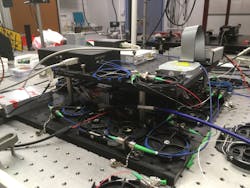Photonic correlator locates objects transmitting a radio signal in real-time
After 10 years of working on frequency-shifting loops, which can generate and manipulate a large number of time-shifted replicas of an input signal, Hugues Guillet de Chatellus at the Université Grenoble Alpes-CNRS in France wondered if they could be used for signal correlation.
During a conversation with two of his colleagues in astronomy, Guillaume Bourdarot and Jean-Philippe Berger from the Institut de Planétologie et d’Astrophysique de Grenoble, they realized frequency-shifting loops have practical applications in astronomy.
“Frequency-shifting loops allow us to solve the problem of the delay line we need to scan to measure the cross-correlation function of two signals,” says Guillet de Chatellus. “It became clear that beyond astronomy, our architecture could have practical applications within other domains.”
He describes this architecture as a photonic resonator based on two optical frequency-shifting loops that can calculate the cross-correlation function of the signals within the optical domain.
To do this, it uses fiber optic components to turn two radio-frequency (RF) signals into optical signals. Once the cross-correlation function is calculated, a detection and processing chain converts it into a digital format.
“First, the architecture transfers two RF input signals into the optical domain. Then, the frequency-shifting loops produce about 200 replicas of the input signals, shifted along the time domain,” explains Guillet de Chatellus. “The recombination of the optical signals on a detector calculates the cross-correlation function of input signals for about 200 values of their relative decay.”
The researchers had already developed a double-frequency-shifting loop architecture for dual-comb spectroscopy applications, so it wasn’t a giant leap to use it for signal correlation. While the experiments weren’t difficult to run, they did need to derive a rigorous mathematical description of the system to provide a full understanding of its properties.
“We were happy to see that while moving the position of the transmitting antenna, the correlation function of the signals collected by the two receivers was shifting—exactly as we predicted,” says Guillet de Chatellus.
During testing, the group demonstrated localization of a RF transmitter with precision close to 10 ps for a 100 ms integration time—meaning the system can locate an emitter with a precision of about 3 mm.
Astronomy applications
The group plans to improve their resonator to cross-correlate signals coming from several telescopes to obtain high-resolution images for astronomy applications.
They’re currently working on a demonstration experiment in which signals emitted from the sun at around 10 GHz will be collected by two remote antennas and cross correlated to create an image of the sun at this radio frequency.
“If these experiments are successful, our device could initiate infrared applications at astronomy facilities, such as the Very Large Telescope Interferometer in Chile, using heterodyne interferometry. This technique is already used for radio-interferometry but was previously limited to narrow correlation bandwidths,” Guillet de Chatellus says.
Entering the battlefield?
So far, the photonic resonator’s architecture measures the relative delay between two signals, which can be used to identify the direction of a remote transmitter—much like RF systems giving the direction or angle of arrival.
“In the next version, we’ll add a third input to localize a transmitter by triangulation,” says Guillet de Chatellus. “If the architecture is deployed on the battlefield, which would require further developments such as stabilization and integration of the architecture, it could enable localizing potential threats and help intercept signals within the frame of electronic warfare.”
Processing wideband signals in real-time is an important advantage within the context of radar signals with ever-increasing complexity to become more frequency agile, which they implemented to ensure low probability of interception.
Since this technology is processing in real-time and works with a wide range of RF signals, it can also be used to localize transmitters, such as radar transmitters, as well as cell phones, signal jammers, and Internet of Things (IoT) tags.
REFERENCE
G. Bourdarot, J.-P, Berger, and H. Guillet de Chatellus, Optica, 9, 3 (2022); doi:10.1364/optica.442906.

Sally Cole Johnson | Editor in Chief
Sally Cole Johnson, Laser Focus World’s editor in chief, is a science and technology journalist who specializes in physics and semiconductors. She wrote for the American Institute of Physics for more than 15 years, complexity for the Santa Fe Institute, and theoretical physics and neuroscience for the Kavli Foundation.
